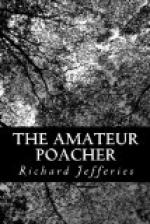They have a special affection for peaty ground, black and spongy, where every footstep seems to squeeze water out of the soil with a slight hissing sound, and the boot cuts through the soft turf. There, where a slow stream winds in and out, unmarked by willow or bush, but fringed with green aquatic grasses growing on a margin of ooze, the snipe finds tempting food; or in the meadows where a little spring breaks forth in the ditch and does not freeze—for water which has just bubbled out of the earth possesses this peculiarity, and is therefore favourable to low forms of insect or slug life in winter—the snipe may be found when the ponds are bound with ice.
Some of the old country folk used to make as much mystery about this bird as the cuckoo. Because it was seldom seen till the first fogs the belief was that it had lost its way in the mist at sea, and come inland by mistake.
Just as in the early part of the year green buds and opening flowers welcome swallow and cuckoo, so the colours of the dying leaf prepare the way for the second feathered immigration in autumn. Once now and then the tints of autumn are so beautiful that the artist can hardly convey what he sees to canvas. The maples are aglow with orange, the oaks one mass of buff, the limes light gold, the elms a soft yellow. In the hawthorn thickets bronze spots abound; here and there a bramble leaf has turned a brilliant crimson (though many bramble leaves will remain a dull green all the winter through); the edible chestnut sheds leaves of a dark fawn hue, but all, scattered by the winds, presently resolve into a black pulp upon the earth. Noting these signs the sportsman gets out his dust-shot for the snipe, and the farmer, as he sees the fieldfare flying over after a voyage from Norway, congratulates himself that last month was reasonably dry, and enabled him to sow his winter seed.
‘Sceap—sceap!’ and very often the snipe successfully carries out the intention expressed in his odd-sounding cry, and does escape in reality. Although I could not at first put my theory into practice, yet I found by experience that it was correct. He is the exception to the golden rule that the safest way lies in the middle, and that therefore you should fire not too soon nor too late, but half-way between. But the snipe must either be knocked over the instant he rises from the ground, and before he has time to commence his puzzling zig-zag flight, or else you must wait till he has finished his corkscrew burst.
Then there is a moment just before he passes out of range when he glides in a straight line and may be hit. This singular zig-zag flight so deceives the eye as almost to produce the idea of a spiral movement. No barrel can ever be jerked from side to side swiftly enough, no hair-trigger is fine enough, to catch him then, except by the chance of a vast scattering over-charge, which has nothing to do with sport. If he rises at some little distance, then fire instantly, because by the time the zig-zag is done the range will be too great; if he starts up under your feet, out of a bunch of rushes, as is often the case, then give him law till his eccentric twist is finished.




